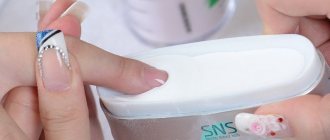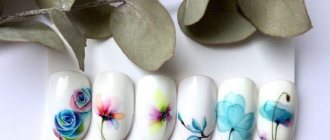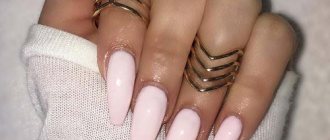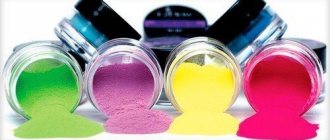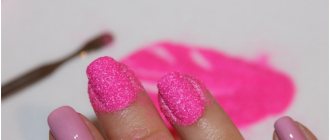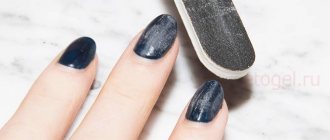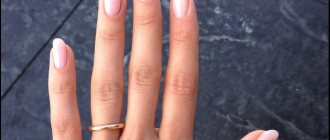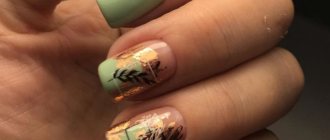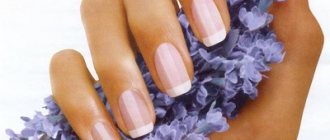Modeling with acrylic
Acrylic nail modeling is one of the extension techniques in which the master works with acrylic. This is a durable material, the distinctive feature of which is the production of a thin plate. Acrylic is a powder and a liquid monomer substance; when these components are combined, a very pliable, plastic mixture is obtained that immediately hardens. There are various options for textures and shades, allowing you to create a unique and original manicure.
Acrylic nails are extended in two ways, the only difference is in the fastening:
- Tips are blanks made of plastic or plastic that imitate the shape of a nail. They are glued to the tip of the nail with special glue. The nail is filed together with the tip and the required length is set. Next, acrylic is applied, polished, and, if necessary, a design is made.
- On the forms - special blanks made of paper or other materials are fixed under the natural nail, then acrylic is applied and modeled, cut down to the required size and polished.
Acrylic is a very durable material, although it can be damaged. To make a beautiful manicure make you happy and last longer, you need to use these tips:
- Protect your hands from cold and too high temperatures, for example, do not mess around in ice and hot water, wear gloves in the cold.
- Try not to hit the hard surface with your nails so as not to injure them.
- Wear gloves when cleaning the house, acrylic does not like exposure to chemicals.
- Take care of your cuticles in a timely manner.
Acrylic nails can be worn for months, but it is recommended to take a break from time to time to allow natural nails to rest and recover. Many people love extensions precisely for their durability. You need to go for correction on time, since the nail grows in 2-3 weeks.
Camouflage powder for nail extension and modeling
Camouflage acrylic powder is used for artificial extension and strengthening of a fragile or damaged natural nail plate in order to hide defects and imperfections of the nails. Detailed information is provided in the text below.
Description of the powder
Acrylic powder is a polymer powder that, after reacting with a liquid, has a porous structure, which allows you to protect the natural nail without causing any harmful effects. The use of a monomer is necessary to give the powder a plastic structure and facilitate application. Camouflage acrylic powders are popular not only as a means for masking imperfections, but also for creating special designs (French manicure, base for nude shades, etc.)
Varieties, features of use
The composition of acrylic powder has standard components and their proportions, except for the quantity and shade of color pigments. A wide range of colors of camouflage powder allows you to choose a shade that matches the color of the skin and natural plate (pink, beige, peach).
The thermoplastic liquid, reacting with acrylic, allows you to create the ideal nail shape quickly and efficiently. The material does not require additional drying. The rapid hardening of the powder requires professional skills and experience, so using acrylic at home is not recommended.
Acrylic powder is used to strengthen, lengthen, and build on forms and tips. The durable structure of the material makes it possible to extend the beauty of the manicure for 3-4 weeks, however, it is important to remember about timely correction to avoid damage and peeling of the artificial coating. It is recommended to work with acrylic wearing a protective mask to avoid harmful effects of vapors due to the reaction of the components.
Camouflage powder is actively used to create three-dimensional designs. The structure of the material allows you to perform sculpting elements, add glitter, stones and various colored pigments to the powder.
Camouflage powder for strengthening
The popular strengthening of the nail plate with acrylic is loved by many women due to its strength and natural appearance. To make the nail plate strong, just apply a small amount of powder with monomer to the natural length and distribute it evenly. Acrylic after hardening is not very plastic, so it is important to control the density of the layer to avoid chips and cracks during wear. Camouflage powder is often used without additional coating. The natural shade gives your nails a beautiful and well-groomed look.
Benefits of acrylic powder
- strength and resistance to mechanical damage;
- rapid drying of the entire thickness of the material;
- the ability to add neon pigment to the entire surface of the material, and not just the finishing layer;
- versatility of use;
- the porous structure allows for quick filing, correction of length and shape;
- a large amount of material and its affordable cost.
Materials and tools
Here is a list of all the necessary tools and materials for acrylic modeling:
- File for extensions with abrasiveness 80/80 or 100/100. The shape of the file is important here; it should be curved to fit the shape of the nail.
- Buff 240 or 360 grit, for polishing. Buff is a file in the form of a three-dimensional rectangle. This file allows you to remove all irregularities. Good polishing means a high-quality and smooth manicure.
- Brush for applying material. It should form a sharp point to form a graceful, straighter smile line, while working with a small bead of acrylic. The brush must have an elastic hair bundle and ensure control of the fluidity of the monomer. A good brush allows you to get high-quality modeling when building up.
- Pusher is a metal tool for pushing back cuticles. Choose the size of the nail plate, it must be well sharpened, the handle itself must have a thread so that the device does not slip out of your hands during operation.
- Form . A special template on which the acrylic mass is laid out during extensions. There are reusable forms, but remember to sterilize them after use.
- Brush to remove dust from the nail plate.
- Bond . It cares for the natural nail, and its main property is the elimination of the fatty film, due to which the extended nails adhere to the nail bed.
- Primer . The basis for further application of substances.
- Acrylic Powder . Polymer powder used for strengthening and modeling. Choose a shade to match your intended design.
- Monomer or liquid, necessary for extension. Liquid is a transparent liquid, it is needed to start the hardening reaction of the powder and performs the main function - it ensures the polymerization of acrylic.
- Pipette to carefully draw up the monomer.
- A napkin to work on.
- Container for mixing powder and monomer.
Write in the comments what would you add to the list?
What is acrylic powder?
Polymerization of this material occurs when the powder is mixed with a liquid monomer. Then you can use this substance to shape the nail until it dries. That's what acrylic powder is. Thus, everything that is applied to the nail hardens without the use of any lamps, in the air. After this, another layer of powder is applied, this time decorative, colored, and the desired shape is created using a file.
Execution technology
The technology of modeling nails with acrylic is more difficult than other techniques. The acrylic extension system consists of powder and liquid monomer. The peculiarity of the last component is a sharp and very nasty smell, so it is important to think about an exhaust hood in the room where the procedure is taking place. At home, do your manicure in a ventilated room.
To do this, use a special brush, which is moistened in monomer and dipped into the powder. It absorbs liquid and becomes a dense soft drop, which is applied using the same brush to the nail plate and distributed with kneading and stretching movements to create a shape. It is very important to do this without delay so that the acrylic does not harden at the wrong moment. Yes, yes acrylic requires a lot of professionalism. The main thing is to practice and not despair.
Step-by-step extension instructions
Let's look at an example of acrylic extensions in the French style step by step. To perform the modeling, you will need an acrylic fixer and powder of three colors: white, pink and camouflage. You can see the remaining tools and materials in the suggested list above. Let's begin!
- Wash your hands
- Using a pusher, we push back the cuticle and clean out the trimmings.
- Use a file to file down the free edge area.
- Using the same nail file, we remove the shine from the nail plate, carefully and gently. Remove any remaining dust with a brush.
- Now we apply Bond to the natural plate.
- Next, take the primer and apply a small amount only to the natural nail.
- Place the form tightly against the rollers, under the nail. Glue the wings from below, press them to the side areas.
- Pour the monomer into the container.
- Take a brush, dip it into a container with monomer and pick up camouflage-colored powder.
- Place the acrylic ball on the edge of the nail plate and gently blend it with soft, pressing movements. Correcting the smile area.
- Next, dip the brush into the monomer, pick up a ball of white powder and shape the free edge, pushing it towards the camouflage acrylic that is already laid out on the nail.
- If you need to complete the shape, then take small balls and apply them.
- Using the technology described above, we take pink acrylic and distribute it on top of camouflage and white acrylic. We form the nail to the end.
- Carefully remove the form from below. Checking how hard the acrylic is. We bend it in two planes with our nails.
- When the acrylic has polymerized, we file along the edges, giving the desired look. We use a file along the plane of the nail to achieve a smooth surface.
- We polish with a buff.
- We paint with a special acrylic fixative.
- Apply oil to the cuticle to soothe and moisturize the skin.
- We repeat the whole process on the remaining nails.
Application of colored acrylic powders
Thanks to technology and innovation, colored acrylic powders have emerged and are used to create a variety of designs. Use your imagination and experiment!
Types of acrylic powders
- Matte. Used to create an aquarium manicure and for a French-style finish.
- Transparent. A universal coating, it is used to create a base layer. Used for sculpting and adjusting the shape of the nail. Easy to apply.
- Camouflage . An important difference is the dense texture. Helps eliminate defects and unevenness of the plate, resulting in a perfect natural manicure.
- Colored. Wide range of colors. Bright saturated colors, ideal for tinting, sculpting three-dimensional details, and unusual jackets.
- Neon. It has a bright, rich color. Used for modeling, French, design.
- With glitter. Different colors, shapes and sizes, thanks to this powder you can create any coating and complement the design.
Powder selection
The choice depends on the type of powder and the result you want to get. Camouflage powder is perfect for smoothing the nail plate and eliminating defects. To strengthen and correct the free edge of the nail, transparent acrylic powder is suitable. It is also used for French manicure. Any colored powder is great for design.
A nail designer who uses acrylic design techniques in his work opens up many possibilities and a creative approach for clients. Acrylic powder is used to paint on the nail plate.
Popular brands of acrylic powder:
- EzFlow – not affected by drafts and temperature changes. Powder color control technology allows the master to be absolutely sure that the color of the acrylic will be the same and uniform. High price.
- Salon Professional – hides defects of natural nail plates well, can be used for any type of manicure. Very fine, so it does not form bubbles. Average price.
- Kodi – elastic material that does not deform the natural plate and does not cause discomfort. This line includes all types of acrylic. Low price.
How to use colored acrylic powder
- Before applying gel polish and powder to your nails, they are prepared in the classic way.
- Then a base coat is applied and dried in a lamp.
- Next, the nail plate is painted with gel polish of the desired color.
- Next, apply a second layer of varnish and dry again in a lamp.
- After drying, a third layer is applied, but not dried (if you need to cover the entire nail with powder) or a pattern is applied using a thin brush (if you need a pattern made of powder).
- Sprinkle the still wet gel polish generously with acrylic powder of the desired color.
- A UV lamp is used again for drying.
- Use a stiff brush to shake off any remaining powder.
